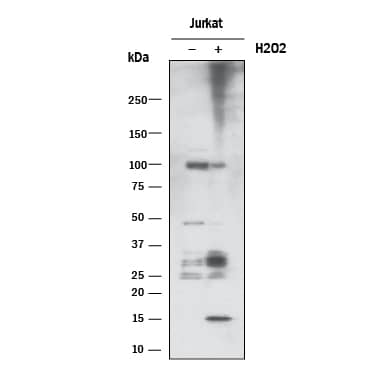Recombinant Human VSIG4 (aa 20-283) Fc Chimera Protein, CF
Recombinant Human VSIG4 (aa 20-283) Fc Chimera Protein, CF Summary
Product Specifications
| Human VSIG4 (Arg20-Pro283) Accession # Q9Y279 |
IEGRMD | Human IgG1 (Pro100-Lys330) |
| N-terminus | C-terminus | |
Analysis
Customers also Viewed
Product Datasheets
Carrier Free
CF stands for Carrier Free (CF). We typically add Bovine Serum Albumin (BSA) as a carrier protein to our recombinant proteins. Adding a carrier protein enhances protein stability, increases shelf-life, and allows the recombinant protein to be stored at a more dilute concentration. The carrier free version does not contain BSA.
In general, we advise purchasing the recombinant protein with BSA for use in cell or tissue culture, or as an ELISA standard. In contrast, the carrier free protein is recommended for applications, in which the presence of BSA could interfere.
4646-VS
| Formulation | Lyophilized from a 0.2 μm filtered solution in PBS. |
| Reconstitution | Reconstitute at 500 μg/mL in PBS. |
| Shipping | The product is shipped at ambient temperature. Upon receipt, store it immediately at the temperature recommended below. |
| Stability & Storage: | Use a manual defrost freezer and avoid repeated freeze-thaw cycles.
|
Background: VSIG4
VSIG4 (V-set and immunoglobulin domain containing 4), also known as CRIg and Z39IG, is a 45 kDa, type I transmembrane protein of the B7 family within the Ig superfamily that is expressed only in tissue-resident macrophages (1-4). The gene is located on the X chromosome (2). The human VSIG4 cDNA encodes 399 amino acids (aa) including a 19 aa signal sequence, a 264 aa extracellular domain (ECD) containing a V-type and a C2-type Ig domain, a 21 aa transmembrane domain and a 95 aa cytoplasmic domain (3). The human VSIG4 ECD shares 84% aa identity with canine VSIG4. Within the IgV domain, it shares 90%, 80% and 78% aa identity with bovine, mouse and rat VSIG4, respectively; these animals lack the C2-type domain. Splice isoforms of 321, 305, 272, 201 and 199 aa lack all or part of the cytoplasmic domain, the C2-type Ig domain and/or the transmembrane domain (5). VSIG4 is specifically expressed on macrophages in the thymic medulla, peritoneum, alveoli, synovia, adipose and heart, liver Kupffer cells, placental Hofbauer cells, and atherosclerotic foam cells (1-4, 6-9). It is absent on infiltrating macrophages (8). VSIG4 is a complement receptor that binds C3b and iC3b fragments, internalizes them to recycling endosomes, and is recycled to the cell surface (4, 6). It contributes significantly to innate immunity by binding and phagocytosis of complement-opsonized invading pathogens (4, 8, 10). Binding of either native or recombinant soluble VSIG4 to C3b inhibits complement amplification through the alternative, but not classical, pathway (10, 11). VSIG4 is also a negative regulator of mouse and human T cell activation (2). Although VSIG4 engagement may activate NF kappa B and thus be pro-inflammatory in some cases, many of its activities are important in resolving, rather than initiating, inflammation (1, 2, 7, 10, 11).
- He, J.Q. et al. (2008) Mol. Immunol. 4041.
- Vogt, L. et al. (2006) J. Clin. Invest. 116:2817.
- Langnaese, K. et al. (2000) Biochim. Biophys. Acta 1492:522.
- Helmy, K. et al. (2006) Cell 124:915.
- Entrez protein Accession # EAX05393, NP_001093901, CAI42052, CAI4205, EAX05394.
- Tanaka, M. et al. (2008) Clin. Exp. Immunol. 154:38.
- Lee, M-Y. et al. (2006) J. Leukoc. Biol. 80:922.
- Gorgani, N.N. et al. (2008) J. Immunol. 181:7902.
- Walker, M.G. (2002) Biochim. Biophys. Acta 1574:387.
- Wiesmann, C. et al. (2006) Nature 444:217.
- Katschke, K.J. et al. (2007) J. Exp. Med. 204:1319.
FAQs
No product specific FAQs exist for this product, however you may
View all Proteins and Enzyme FAQsReconstitution Buffers
Reviews for Recombinant Human VSIG4 (aa 20-283) Fc Chimera Protein, CF
There are currently no reviews for this product. Be the first to review Recombinant Human VSIG4 (aa 20-283) Fc Chimera Protein, CF and earn rewards!
Have you used Recombinant Human VSIG4 (aa 20-283) Fc Chimera Protein, CF?
Submit a review and receive an Amazon gift card.
$25/€18/£15/$25CAN/¥75 Yuan/¥2500 Yen for a review with an image
$10/€7/£6/$10 CAD/¥70 Yuan/¥1110 Yen for a review without an image















